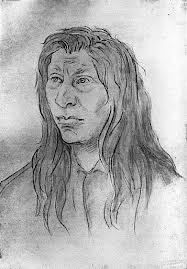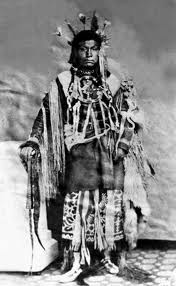(excerpt from draft of The Last 100 Miles)
Kamaiakin and the Klickitat Wars of 1855-56
One of the more interesting characters from this era was the Klickitat leader, Kamaiakun who resided with his bands in the proximity of Mt. Rainier. Although their upland territory was not the target of Euro-American expansion, the huge influx of settlers into the northern Willamette and extending northwards were putting pressure on the Yakima Nation, among whose major tribes were the horse riding Klickitat Indians.
In a remarkable travelogue, The Canoe and The Saddle written by the twenty-four year old New Englander, Theodore Winthrop, we get a first-hand report on the character of this Klickitat leader. He describes how they meet by chance during the late August of 1853 in the highlands near the 4,800 ft. high Naches Pass. In this account Winthrop writes about the quiet dignity of this Yakima chieftain who would go on to launch a war on the white settlers only two years later.
Winthrop had only recently graduated from Yale in 1848 and was “touring” the Pacific Northwest. His book, although riddled with the contradictions and prejudices of the New England aristocrat, is one of the best early travel narratives to describe the raw beauty of the region, and the natives that he encountered.
“Enter, then, upon this scene Kamaikin, the chiefest of the Yakimah chiefs. He was a tall, large man, very dark, with a massive square face, and grave, reflective look…his manner was strikingly distinguished, quiet and dignified.
Kamaiakin, in order to be the chiefest chief of the Yakimah’s must be clever enough to master the dodges of the salmon, and the will of the wayward mustang…he must know where the kamas bulbs are mining a passage for their sprouts, or he must be able to tramp farther and fare better than his fellows; or by a certain ‘tamanous’ (magic) that is in him, he must have power to persuade or convince to win or overbear. ”
At the meeting Winthrop asks Kamaikin for a guide that will get him to The Dalles, where he is anxious to meet fellow travelers bound eastward. Kamiakin introduces Winthrop to the guide that will ultimately deliver him to his rendezvous. Not surprisingly, Winthrop, in his adieu extolls his host as the “prudent and weighty” chief.
In retrospect, we can see how Theodore Winthrop is himself a symptom of the seismic shifts affecting the Pacific Northwest. Whites are tramping all over the region, surveyors are planning railroad routes through the Cascades, miners are befouling the streams, the settlers’ pigs are destroying the Indians camas fields, river navigation is literally wrecking the Indians’ fisheries and land speculators are selling the Indians’ patrimony right out from under their feet. Simultaneously, the region is beset with new outbreaks of smallpox, measles and malaria that reduce the Indian population of the Lower Columbia from 15,000 in 1830 to less than 2,000 in the mid-1840’s. Winthrop is a witness to this epic transformation, but he is unapologetic for its consequences to the indigenous cultures. After a brief encounter with a group of road builders, he boasts that he “could ride more boldly forward into savageness, knowing that the front ranks of my nation were following close behind.”
Given the wide ranging impacts wrought by the increasing inflow of settlers on the existing Indian way of life, it should come as no surprise that this “prudent and weighty” chief would be at the center of Klickitat resistance to the the white setters’ encroachments. Within twelve months of this chance encounter in the woods, Kamaikin was sending messengers to his allies East of the Cascades warning them to fight to retain their home hunting grounds and the lands where their ancestors were buried.
Deadly confrontations with miners, and the murder of the Yakimah chieftain, Peu-peu-mox-mox’s son by white settlers had seriously degraded relations with the Klickitats on the Columbia Plateau. In 1855, the settlers tried to buy their way out of the impending conflict, but Peu-peu-mox-mox would have none of it. Realizing the seriousness of this refusal and the likelihood of further violence, A.J. Bolen, the Indian agent in charge of relations with the Yakimahs met with one of the Yakimah sub-chiefs to warn them against further conflict and threatened to send the soldiers up to kill them if they misbehaved. Incensed by these demands, Bolen was followed on his return trip and killed by some young warriors. They subsequently burned his body and that of his horse, dancing on his scalp as the carcasses were reduced to ashes.
This frightful ritual of revenge reported back to the whites, who immediately dispatched all the women and children by canoe to the safety of The Dalles. At the same time the ranking officer in The Dalles, Major Haller mobilized 107 mounted soldiers and set off with enough supplies to conduct a month-long campaign against the errant Yakimah’s. Two days out they skirmished with the Indians. One soldier was killed and seven wounded, but Haller’s command was surrounded by over 700 angry Yakimahs. The soldiers retreated to a nearby ridge. A scout was successfully dispatched to sneak through the Indian lines to summon help, but the next day the Indians managed to kill two soldiers and wounded 13 more. The situation was perilous, but fortunately the scout managed to find a route down the steep bluff and the soldiers quickly abandoned their rocky redoubt to flee back to The Dalles.
Kamaiakin sued for a negotiated peace, but the Governor of the Washington territories Isaac Stevens wanted to use the conflict to force the Indians into reservations. Responding to Kamaiakin’s offer, he wrote that,
“the whites are as the stars in the heavens, or the leaves in the trees in the summer time. Our warriors in the field are many , as you must see; but if not enough, a thousand for every one more will be sent to hunt you and to kill you; and my advice to you, as you will see, is to scatter yourselves among the Indians tribes more peaceable and therefore forget you were ever Yakimahs.”
The settlers began building forts everywhere marginalizing the Indian attacks. It was a slow deliberate approach but it forced the Indians to seek unity, which in turn polarized the Indian community. Smaller tribes that tried to evade the conflict soon found that their horses were raided, and their tribal chieftains killed as power struggles rent the tribal society. In the end the Nez Perce whose participation might have changed the outcome, stood aside and refused to join the growing rebellion. Those more inclined to negotiate with the emerging American civil and military authority ultimately gained the ascendancy. The saturation of forts across the inland plateau country of the Pacific Northwest effectively heralded the futility of militant resistance. In the end the “prudent and weighty” chieftain, Kamaiakin was forced to flee into exile – just as Isaac Stevens had recommended.



Terrific! Enjoy reading these rarely heard histories of the Pacific NW. Also love anything about the Oregon Coast Range- I walk through its edges east of Neskowin.
Jim, Thank you! My curiosity with your subject is related to an ancestor, Lorenza Elliot, 4th US Infantry 1855-60. An old family transcript reads that he was involved with the Indian wars in Oregon/Washington.
thanks this was great